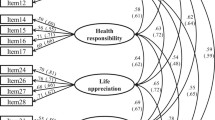Abstract
The WHOQOL-BREF is one of the cross-cultural and widely used measures for assessing health-related quality of life (HRQOL). Previous studies of the HRQOL using the WHOQOL-BREF mainly focused on adult; however, there has been less work carried out on assessing the HRQOL on early adolescence. The goal of this study was to examine the applicability of the WHOQOL-BREF Taiwan version in early adolescent sample. A total of 365 junior high school students participated in this study. Participants completed the WHOQOL-BREF Taiwan version and five visual-analogue items on HRQOL evaluation. The results supported the originally designed four-factor model, and also indicated good item discrimination, internal reliability, factorial validity (by using confirmatory factor analysis) and construct validity (e.g., predictive validity, discriminant and convergent validity) after deleting two physical health items (i.e., “To what extent do you feel that your pain hinders you in doing what you need to do”; “Do you need medical treatment to cope with your daily life?”) and one social relationships item (i.e., “Are you satisfied with your sex life?”). Overall, this study provides the applicability of the WHOQOL-BREF Taiwan version in early adolescence. In addition, the WHOQOL-BREF Taiwan version may be of use to health professionals in the assessment and comparison of different age groups from early adolescence to adulthood.
Similar content being viewed by others
Reference
G.R. Adams, L.D. Bennion, D.K. Openshaw and C.R. Bingham, ‘Windows of vulnerability: Identifying critical age, gender, and racial differences predictive of risk for violent deaths in childhood and adolescence’. Journal of Primary Prevention 10 (1990) 223-240
G.R. Adams, T.P. Gullotta and C. Markstrom-Adams, ‘Adolescent Life Experiences’. Pacific Grove, CA: Brooks/Cole Publishing Company (1994).
M. Apajasalo, C. Sintonen, C. Holmberg and J. Sinkkonen, ‘Quality of life in early adolescence: A sixteen-dimensional health-related measure (16D)’. Quality of Life Research 5 (1996) 205-211
M.W.L. Cheung and W. Chan, ‘Testing dependent correlation coefficients via structural equation modeling’. Organizational Research Methods 7 (2004) 206-223
C. Eiser, ‘Growing Up with a Chronic Disease’. London: Jessica Kingsley Publishers (1995).
C. Eiser and R. Morse, ‘Can parents rate their child’s health-related quality of life? Results of a systematic review’. Quality of Life Research 10 (2001) 347-357
E.H. Erikson, ‘Childhood and Society’. New York: W. W. Norton and Company (1953).
C.T. Fang, P.C. Hsiung, C.F. Yu, M.Y. Chen and J.D. Wang, ‘Validation of the World Health Organization quality of life instrument in patients with HIV infection’. Quality of Life Research 11 (2002) 753-762
H.D. Grotevant, ‘Identity process: Integrating social psychological and developmental approach’. Journal of Adolescent Research 12 (1987) 354-357
C.E. Irwin, ‘Adolescent social behavior and health’. In: W. Damon (ed.) New Directions for Child Development. San Francisco: Jossy-Bass (1987) pp. 1-12
P. Jirojanakul, S.M. Skevington and J. Hudson, ‘Predicting young children’s quality of life’. Social Science & Medicine 57 (2003) 1277-1288
Joreskog, K.G. and D. Sorbom: 1993, ‘LISREL 8: Structural Equation Modeling with the SIMPLIS Command Language. Chicago, IL, US; Hillsdale, NJ, England: Scientific Software International', Inc.; Lawrence Erlbaum Associates, Inc
M.R. Lin, W. Huang, C. Huang, H.F. Hwang, L.W. Tsai and Y.N. Chiu, ‘The impact of the Chi-Chi earthquake on quality of life among elderly survivors in Taiwan: A before and after study’. Quality of Life Research 11 (2002) 379-388
R.K. Mulhern, M.E. Horowitz, J. Ochs, A.G. Friedman, F.D. Armstrong, D. Copeland and L.E. Kun, ‘Assessment of quality of life among pediatric patients with cancer’. Psychological Assessment 1 (1989) 130-138
D. Raphael, E. Rukholm, I. Brown, P. Hill-Bailey and E. Donato, ‘The quality of life profile-adolescent version: Background, description, and initial validation’. Journal of Adolescent Health 19 (1996) 366-375
M.E.P. Seligman and M. Csikszentmihalyi, ‘Positive psychology: An introduction’. American Psychologist 55 (2000) 5-14
S.M. Skevington, ‘Advancing cross-cultural research on quality of life: Observations drawn from the WHOQOL development’. Quality of Life Research 11 (2002) 135-144
S.M. Skevington, M. Lotfy and K.A. O’Connell, ‘The World Health Organization’s WHOQOL-BREF quality of life assessment: Psychometric properties and results of the international field trial’. Quality of Life Research 13 (2004) 299-310
L.E. Spieth and C.V. Harris, ‘Assessment of health-related quality of life in children and adolescents: An integrative review’. Journal of Pediatric Psychology 21 (1996) 175-193
J.E. Ware, M. Kosinski and S.D. Keller, ‘A 12-item short-form health survey’. Medical Care 34 (1996) 220-228
World Health Organization: 1993, ‘WHOHR-QOL study protocol’. Geneva: WHO (MNH/PSF/93.9)
World Health Organization: 1995, ‘Resources for new WHOHR-QOL centers’. Geneva: WHO (MNH/PSF/95.3)
‘Development of the World Health Organization WHOQOL-BREF quality of life assessment’. Psychological Medicine 28 (1998a) 551-558
‘The World Health Organization Quality of Life assessment (WHOQOL): Development and general psychometric properties’. Social Science and Medicine 46 (1998b) 1569-1585
WHOQOL-Taiwan Group: 2001, ‘Development and manual of the World Health Organization WHOQOL-Taiwan quality of life assessment'
G. Yao, C.H. Chung, C.F. Yu and J.D. Wang, ‘Development and verification of validity and reliability of the WHOQOL-BREF Taiwan version’. Journal of the Formosan Medical Association 101 (2002) 342-351
Author information
Authors and Affiliations
Corresponding author
Rights and permissions
About this article
Cite this article
Chen, KH., Wu, CH. & Yao, G. Applicability of the WHOQOL-BREF on early adolescence. Soc Indic Res 79, 215–234 (2006). https://doi.org/10.1007/s11205-005-0211-0
Accepted:
Published:
Issue Date:
DOI: https://doi.org/10.1007/s11205-005-0211-0




